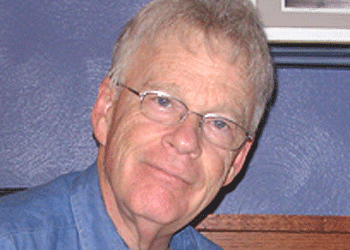In this week’s issue… Craig to retire – WOR’s new night show – Regional broadcaster closes studios – WSKG realigns radio lineups – Remembering Steve Dodge
By SCOTT FYBUSH
*Maybe it’s this week, or maybe it was last week – the details are lost in the mists of the very earliest history of the internet, but one way or another, the column you’re reading this week is now 25 years old.
When we started as “New England Radio Watcher” on USENET’s rec.radio.broadcasting back in 1994, the biggest story of our first few years was the consolidation of the industry, first in the form of some of the earliest duopolies, and then much bigger clusters as ownership regulations were relaxed.
 And in that business back then, especially in MASSACHUSETTS, there was nobody taking as aggressive advantage of the new rules as Steve Dodge, chairman of Boston-based American Radio Systems. Which is why we’re saddened indeed this week to start our 25th anniversary column with news of Dodge’s untimely death. On Wednesday, Dodge was on his bicycle in Bonita Springs, Florida when police say he made an illegal turn into traffic, where his bike was hit by a car, killing him at age 73.
And in that business back then, especially in MASSACHUSETTS, there was nobody taking as aggressive advantage of the new rules as Steve Dodge, chairman of Boston-based American Radio Systems. Which is why we’re saddened indeed this week to start our 25th anniversary column with news of Dodge’s untimely death. On Wednesday, Dodge was on his bicycle in Bonita Springs, Florida when police say he made an illegal turn into traffic, where his bike was hit by a car, killing him at age 73.
Dodge’s career in media began after his service in the Navy; he then graduated from Yale and went to work for BankBoston, which assigned him to analyze the cable TV industry of the 1970s. That experience led him to form his own cable company, American Cablesystems, which he sold to Continental Cablevision in 1988.
Dodge’s next chapter was radio, starting with his formation of Atlantic Ventures, which was in the right place at the right time to acquire WEZO (101.3)/WNYR (990) in Rochester from Malrite – and then to go big, buying what had been RKO General’s Boston stations, WRKO (680) and WROR (98.5) for more than $28 million. In 1993, Atlantic Ventures merged with Stoner Broadcasting and Multi Market Communications to create American Radio Systems, which quickly began snapping up properties as the FCC relaxed its ownership rules.
 In Boston, Dodge’s ARS bought WRKO’s longtime competitor WHDH (850), then acquired the intellectual property of WEEI (590), moving WEEI’s sports format up the dial and abruptly ending WHDH’s long radio history. In Rochester, ARS tested the edges of the FCC’s new limits with its 1997 acquisition of the Lincoln Group’s cluster (WHAM/WVOR/WHTK/WHRR/WPXY) in Rochester, creating a test case in which the Justice Department intervened, forcing a big chunk of the Lincoln Group to be spun off to Jacor and setting the stage for several subsequent realignments in the market.
In Boston, Dodge’s ARS bought WRKO’s longtime competitor WHDH (850), then acquired the intellectual property of WEEI (590), moving WEEI’s sports format up the dial and abruptly ending WHDH’s long radio history. In Rochester, ARS tested the edges of the FCC’s new limits with its 1997 acquisition of the Lincoln Group’s cluster (WHAM/WVOR/WHTK/WHRR/WPXY) in Rochester, creating a test case in which the Justice Department intervened, forcing a big chunk of the Lincoln Group to be spun off to Jacor and setting the stage for several subsequent realignments in the market.
And then in 1998, ARS itself succumbed to the consolidation trend, selling its 98 radio stations to CBS for $1.6 billion. By then, ARS included significant clusters in Hartford and Buffalo, as well as in growing medium markets such as Sacramento and Charlotte. Once again, ownership limits forced some spinoffs – in Boston, WRKO, WEEI, WEGQ (93.7), WAAF (107.3) and WWTM (1440 Worcester) went to Entercom, creating a new cluster that would again be reshuffled 20 years later when Entercom itself acquired CBS’ radio stations.
One piece of ARS didn’t go to CBS, though; Dodge kept the tower sites, creating a new company called American Tower Corp. It, too, became (and remains) a behemoth, timed out perfectly to capture a huge increase in marketplace demand for tower space not only for broadcasters but also for cellular and other wireless needs. Dodge stepped away from American Tower, later starting a real estate development company building luxury homes and commercial developments on the North Shore and in southwest Florida.
Argue all you’d like about whether or not the consolidation of the 1990s was a good thing, or about whether American Tower’s dominance of that industry is a plus – but there’s almost nobody in the business this week with an unkind word to say about Steve Dodge himself and the many careers and companies he built for himself.
SPRING IS HERE…

And if you don’t have your Tower Site Calendar, now’s the time!
If you’ve been waiting for the price to come down, it’s now 30 percent off!
This year’s cover is a beauty — the 100,000-watt transmitter of the Voice Of America in Marathon, right in the heart of the Florida Keys. Both the towers and the landscape are gorgeous.
And did you see? Tower Site of the Week is back, featuring this VOA site as it faces an uncertain future.
Other months feature some of our favorite images from years past, including some Canadian stations and several stations celebrating their centennials (buy the calendar to find out which ones!).
We still have a few of our own calendars left – as well as a handful of Radio Historian Calendars – and we are still shipping regularly.
The proceeds from the calendar help sustain the reporting that we do on the broadcast industry here at Fybush Media, so your purchases matter a lot to us here – and if that matters to you, now’s the time to show that support with an order of the Tower Site Calendar. (And we have the Broadcast Historian’s Calendar for 2025, too. Why not order both?)
Visit the Fybush Media Store and place your order now for the new calendar, get a great discount on previous calendars, and check out our selection of books and videos, too!
[private]
 *How many music morning shows have lasted as long at the same place as Gary Craig’s “Craig and Company” on WTIC-FM (96.5) in Hartford, CONNECTICUT? Craig started at WTIC-FM way back in 1981, crossed the street in 1992 to competitor WKSS (95.7), then came back to TIC-FM (by then owned by ARS) in 1996 and stayed put.
*How many music morning shows have lasted as long at the same place as Gary Craig’s “Craig and Company” on WTIC-FM (96.5) in Hartford, CONNECTICUT? Craig started at WTIC-FM way back in 1981, crossed the street in 1992 to competitor WKSS (95.7), then came back to TIC-FM (by then owned by ARS) in 1996 and stayed put.
But sometime in June, Craig will step away from his job at what’s now Entercom. Craig, now 68, made the announcement Monday morning, telling listeners he came to the decision while driving into work.
“I really hate goodbyes; goodbyes suck. But everything good or bad has to come to an end eventually. I mean, nothing lasts forever,” he told his audience. “I think I’ve been at the fair a little too long.”
It’s not at all clear yet who’ll replace Craig on WTIC-FM (to the extent replacing him is even possible); Craig also says he’s not sure what he’s going to do next.
*It’s been a year now since the FCC eliminated its main studio rule, allowing stations to originate programming legally from anywhere (not that they couldn’t have done most of that anyway under the old rules.)
When the rules went away, there was immediate speculation that big broadcasters would begin shuttering small-market studios right away – but for the most part, they didn’t. Sure, iHeart closed its little storefront space in Canandaigua that provided a “legal studio” for two stations that were just a little too far to have their official main studios in Rochester, 20 miles away, and Entercom removed its public files and mic mixers from a few satellite locations on the edges of its Scranton and Buffalo clusters. But it’s only now that we’re seeing a group make a bigger move, and it’s not one of the very biggest groups.
This time it’s Townsquare Media, which controls nearly all of the commercial radio landscape between Binghamton and Albany along the I-88 corridor (as well as owning significant clusters in Binghamton, Albany and Utica.) When it bought the former Double O group in 2011, Townsquare inherited three studio locations for its eleven stations. WDOS (730), WZOZ (103.1) and WSRK (103.9) are in downtown Oneonta; WCHN (970), WKXZ (93.9) and WBKT (95.3) are 25 miles or so to the west in Norwich – and a fairly new studio in downtown Walton, 30 miles to the south, houses Walton’s WDLA (1270) and WDLA-FM (92.1) as well as oldies WIYN (94.7 Deposit)/WDHI (100.3 Delhi) and adult hits WTBD (97.5 Delhi).
 When we stopped by the Walton studios late last year to say farewell to veteran WDLA morning man Ron Galley (hear his interview on the Top of the Tower Podcast), the office suite was pretty empty – and now it’s going to get much emptier. NERW has learned that Townsquare is closing the Walton and Norwich studios, moving the eight outlying stations into its downtown Oneonta location on Chestnut Street.
When we stopped by the Walton studios late last year to say farewell to veteran WDLA morning man Ron Galley (hear his interview on the Top of the Tower Podcast), the office suite was pretty empty – and now it’s going to get much emptier. NERW has learned that Townsquare is closing the Walton and Norwich studios, moving the eight outlying stations into its downtown Oneonta location on Chestnut Street.
We’re hearing that four Townsquare staffers will lose their jobs as a result of the move. It’s not yet clear what will suffer on the air; especially after Galley’s departure from WDLA, the Norwich and Walton studios weren’t producing a lot of local content for those areas, and even Oneonta had a lot of automation on the air. Still, it can’t be good news for listeners in Norwich, Walton or Delhi to have what’s left of their local stations moving 45 minutes or more down the road.
*It’s increasingly unusual these days to see public radio stations with block formats that mix long stretches of music with news magazines and talk shows – which is why even the management at Binghamton’s WSKG admitted that the programming realignment they’re making next month is many years overdue.
Back in 1995 when WSKG launched a second FM service, WSQX (91.5 Binghamton) was a relatively low-powered sister to big WSKG (89.3). And while WSKG expanded its main FM service all across the southern tier from Hornell to Oneonta, the WSQX service picked up only two small translators in Corning and Ithaca and one more full-power signal, WSQN (88.1 Greene), filling a hole between Binghamton and Oneonta along I-88.
So it made sense for a while to use the main WSKG network to mix classical music with “Morning Edition” and “All Things Considered.” WSQX, meanwhile, started out playing mostly jazz, but in more recent years had become mostly a news and talk station, carrying NPR’s daytime news magazines, BBC World Service and a smattering of jazz on weekends.
That will all change Sunday, February 3, when WSKG realigns its radio services into “WSKG News” and “WSKG Classical.” The news programming will go full time on WSKG’s big FM signals – WSKG (89.3 Binghamton), WSQG (90.9 Ithaca), WSQE (91.1 Elmira), WSQA (88.7 Hornell), WSQC (91.7 Oneonta). The smaller WSQX network, meanwhile, will be rebranded as “WSKG Classical,” retaining Bill Snyder’s local midday classical show and adding syndicated classical content to fill out the weekday lineup. A few vestiges of jazz and AAA music will remain on weekends, including a local show from WSKG’s Crystal Sarakas. (The “WSKG Classical” programming will also be available via HD2 on most of the big WSKG News signals, and it’s a little odd that the station’s marketing of the changes hasn’t mentioned that much, even as it acknowledges that some listeners will lose easy access to classical as a result of the changes.)
*Down the road in New York City, the Mets’ move from iHeart’s WOR (710) to Entercom’s WCBS (880) is bringing changes at both ends. At WOR, Pete McCarthy’s evening “Sports Zone” show ended when the Mets season did last June. (Correction: we are reliably informed that the team in fact kept playing through the end of September, for some reason, and that McCarthy’s show lasted that long as well.) After filling the 6-9 PM hours all winter with a replay of Len Berman’s morning show, WOR is getting ready to go back to live and local starting February 4, when it launches “WOR Tonight.”
The new show will feature Joe Concha of The Hill, a regular Fox News commentator, squaring off against Liz Wiehl, an ex-prosecutor and Fox News legal analyst who worked for House Democrats during the Clinton impeachment hearings. Can local make a difference against the syndicated Mark Levin on Cumulus’ WABC and Jay Sekulow and Larry Elder on Salem’s WNYM?
 Meanwhile at WCBS, Wayne Randazzo has been formally named to the second chair in the Mets booth alongside Howie Rose. Randazzo, who’d been doing pre- and post-game coverage on WOR, replaces Josh Lewin, who’s now at Entercom’s KWFN (97.3 San Diego) as part of the Padres radio lineup. Ed Coleman, a familiar Mets voice from their days on WFAN, will take on pre- and post-game duties at WCBS when spring training coverage begins Feb. 23 from Florida.
Meanwhile at WCBS, Wayne Randazzo has been formally named to the second chair in the Mets booth alongside Howie Rose. Randazzo, who’d been doing pre- and post-game coverage on WOR, replaces Josh Lewin, who’s now at Entercom’s KWFN (97.3 San Diego) as part of the Padres radio lineup. Ed Coleman, a familiar Mets voice from their days on WFAN, will take on pre- and post-game duties at WCBS when spring training coverage begins Feb. 23 from Florida.
*Back at Cumulus, WPLJ (95.5) has shifted its Todd & Jayde morning show a half-hour earlier, starting at 5:30 and signing off at 8:30, when the hot AC station shifts into a 90-minute jockless music block. WPLJ has also lost night guy Ralphie Aversa, whose exit takes him out of tracking middays at WBHT/WBHD in Wilkes-Barre/Scranton and nights at WPRO-FM (92.3) in Providence, RHODE ISLAND. APD Mike Allan replaces Aversa at WPLJ, Kara’s now in middays at BHT and no replacement has been named at PRO-FM.
As long as we’re down I-80 in northeast PENNSYLVANIA, we note that Bryan Baylee has exited Entercom’s WGGY (Froggy 101.3), where he’d been night host (as “Brian Thompson”) and promotions coordinator for the last three years.
Over in Pittsburgh, Steve Blass is getting ready for his final season in the Pirates broadcast booth. A lifelong Buc, Blass started with the team as a pitcher in the minor leagues in 1960 and never left, reaching the parent team in 1964, moving into community service after retiring in 1975, and then, in 1983, joining the TV booth. He’s been doing radio (on KDKA 1020 and then KDKA-FM 93.7) since 1986, but at age 76, Blass says this is his last year there.
What’s going on at Steel City Media’s WLTJ (92.9 Pittsburgh)’s HD2? After playing nonstop Christmas music, it’s now “Lite Rock 92.9-HD2,” playing soft AC from the seventies and eighties with a pair of synthesized voices making announcements between songs.
 *In eastern CANADA, the trend toward soft AC accelerated rather abruptly last week. No sooner did Stingray announce a Thursday flip of CKUL (96.5 Halifax) from hot AC “Mix” to soft AC “Breeze” than competitor Evanov beat it to the punch. On Wednesday night at 7, Evanov pulled the plug on active rock at CKHY (105.1 Halifax), replacing “Rock 105” with the “Jewel” soft AC format that the company uses in several other markets.
*In eastern CANADA, the trend toward soft AC accelerated rather abruptly last week. No sooner did Stingray announce a Thursday flip of CKUL (96.5 Halifax) from hot AC “Mix” to soft AC “Breeze” than competitor Evanov beat it to the punch. On Wednesday night at 7, Evanov pulled the plug on active rock at CKHY (105.1 Halifax), replacing “Rock 105” with the “Jewel” soft AC format that the company uses in several other markets.
Stingray still went ahead with Thursday’s flip at CKUL, putting soft AC on two big signals in town – and also on Wayne Harrett’s independent CFEP (105.9 Eastern Passage), which has been doing a full-service standards/easy listening format for years as “Seaside FM.”
*A CRTC hearing on March 19 could mean the end of yet another AM station in eastern Canada. Stingray’s CHCM (740 Marystown NL) rebroadcasts talk/full-service VOCM (590) from St. John’s – and now it wants to abandon the AM dial, moving to FM with 59.3 kW on 88.3. The hearing will also consider an application from Cape Breton University’s CJBU (107.3 Sydney NS) to go from 5 to 50 watts, and from religious CINB (96.1 Saint John NB) to go from 50 to 1726 watts (2.5 kW max DA).
*In western Quebec, Steve Faguy reports Cogeco is dropping the “Pop” branding at CJLA (104.9 Lachute) and CHPR (102.1 Hawkesbury ON), replacing it with “Wow,” a brand Cogeco acquired as part of its purchase of RNC Media stations. (RNC kept “Pop” for its stations in Quebec City and Gatineau.)
In Montreal, top-rated CHMP (98.5) is changing up its talk lineup – but not until autumn, when Patrick Lagacé will move from weekend mornings to weekday afternoons, switching timeslots with Paul Houde.
[/private]












